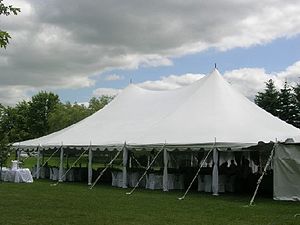This article has multiple issues. Please help improve it or discuss these issues on the talk page. (Learn how and when to remove these messages)
|


A pole marquee or pole tent is a variety of large tent often used to shelter summer events such as shows, festivals, and weddings. They are particularly associated with typical English country garden weddings and village fetes.
The basic design has changed little in thousands of years. A pole marquee consists of a roof canopy supported by tall central poles ("king poles") tensioned using side lines connected to ground pins (or stakes) and smaller supporting poles ("side poles"). The king poles support the bulk of the weight, while the side poles give the fabric shape.
Originally, they were manufactured from cotton canvas covers, wooden poles, and hessian rope but these materials have been largely replaced with more modern equivalents. In the UK, hire companies offer "American-style" pole tents with PVC covers, aluminium poles, and nylon ropes.
The introduction of modern fabrics has extended the useful life of marquee covers and made them far easier to clean. Canvas marquees are still available and in recent years have seen a resurgence as natural materials become fashionable once more. Both materials offer some advantages over the other, particularly that the breathability of canvas allows better air circulation, but that PVC covers better withstand phototendering.
It is inadvisable to use a traditional marquee during winter months due to the hazards associated with snow buildup, damp ground and high winds. With these inherent limitations, marquees are better equipped for warm, still weather unless fitted with features designed to reduce these hazards.
References
- https://archive.today/20090416002723/http://www.performancetextiles.org.uk/public/marqGuide.asp Performance Textiles Association - A Useful Guide to Marquees
External links
Understanding the Four Basic Party Tent Styles: Frame Tents vs Pole Tents
| Tents and overnight shelters | |
|---|---|
| Traditional types | |
| Modern types | |
| Equipment | |
| Related topics | |